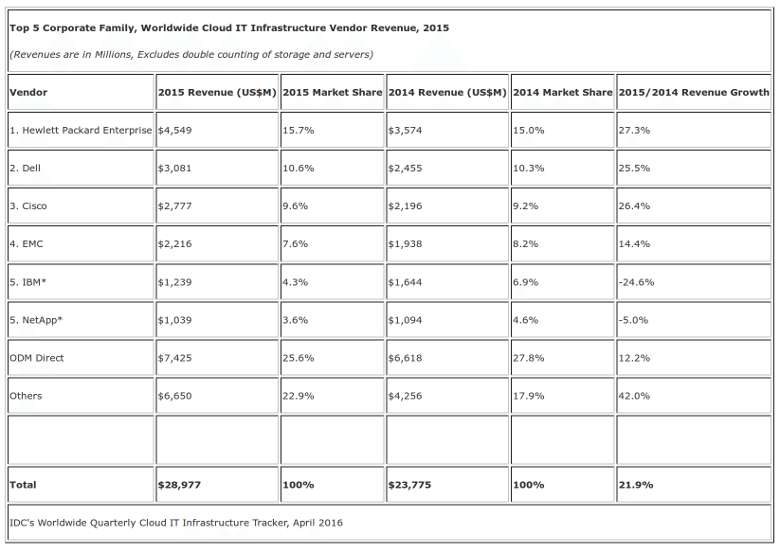Cloud IT infrastructure spend at $29B in 2015: IDC
Vendor revenue from sales of infrastructure products (server, storage, and Ethernet switch) for cloud IT, including public and private cloud, grew by 21.9 percent, year over year to $29.0 billion in 2015, as according to research firm IDC.
The vendor revenue for the fourth quarter (4Q15) grew 15.7% to $8.2 billion, the research firm said in an official release.

Private cloud finds growth; but revenues more in public cloud
Compared to overall IT infrastructure spending, the share of cloud IT infrastructure sales climbed to 32.2% in 4Q15, up from 28.6% a year ago. Revenue from infrastructure sales to private cloud grew by 17.5% to $3.3 billion, and to public cloud by 14.6% to $4.9 billion. In comparison, revenue in the traditional (non-cloud) IT infrastructure segment decreased 2.7% year over year in the fourth quarter, with declines in all three technology segments (server, storage and Ethernet switch). All three technology markets showed strong year-over-year growth in both private and public cloud segments, except for storage in the public cloud, which declined 4.0% in 4Q15 on a difficult compare with a very strong quarter in the prior year. Private cloud growth was led by Ethernet switch with 19.6% growth. In public cloud, Ethernet switch led the way with 56.9% year-on-year growth, while public cloud revenue from server grew 28.9% year on year in 4Q15. For the full year, server revenue in private cloud grew by 23.0% year on year, while Ethernet switch revenue in public cloud grew by 36.6% during the same period. “The cloud IT infrastructure market continues to see strong double-digit growth with faster gains coming from public cloud infrastructure demand,” said Kuba Stolarski, Research Director for Computing Platforms at IDC.“End customers are modernizing their infrastructures along specific workload, performance, and TCO requirements, with a general tendency to move into 3rd Platform, next-gen technologies. Options on and off premises continue to expand, along with open platforms that enhance hybrid capabilities for a variety of use cases.”
Public cloud to grow steadily
Public cloud as-a-service offerings also continue to mature and grow in number, allowing customers to increasingly use sophisticated, mixed strategies for their deployment profiles. While the ice was broken a long time ago for public cloud services, the continued evolution of the enterprise IT customer means that public cloud acceptance and adoption will continue on a steady pace into the next decade.Japan: the fastest
From a regional perspective, vendor revenue from cloud IT infrastructure sales grew fastest in Japan at 50.0% year over year in 4Q15, followed by Asia/Pacific (excluding Japan) at 38.7%, Western Europe at 30.5%, Canada at 23.5%, and the United States at 6.6%. Central and Eastern Europe declined 9.3% year over year as the region continues to go through political and economic turmoil, which impacts overall IT spending.
